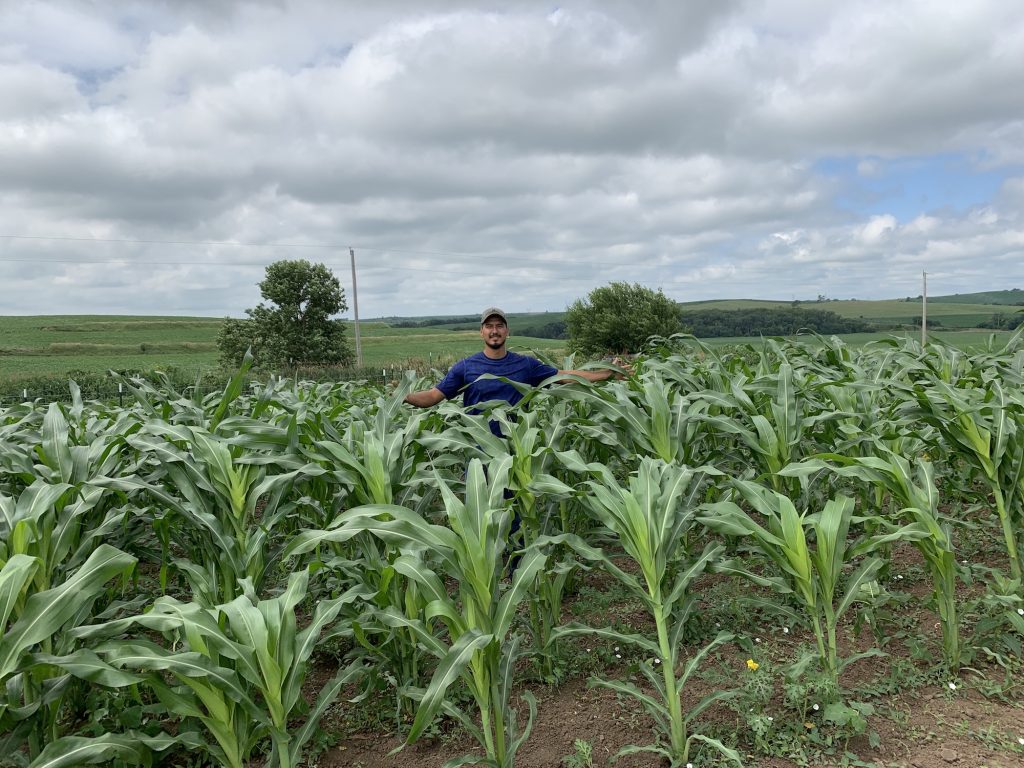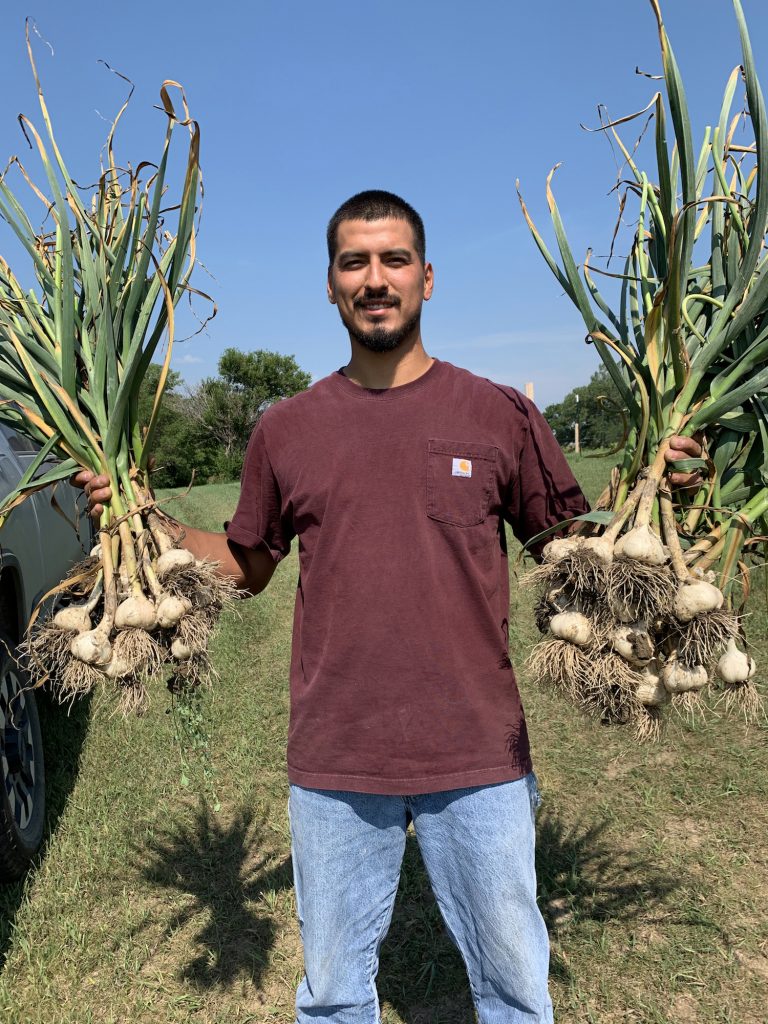Little Priest Tribal College student Trey Blackhawk is showing his community that they can grow their own food in a way that benefits the land and themselves.
By Katie Scarlett Brandt

Trey Blackhawk’s roots run deep on the Winnebago Reservation in northeastern Nebraska, where he was born and raised. “This is where I feel my help is needed. I’m doing my best. I felt like it was a calling, so here I am doing it, getting the job done.”
Two years ago, Blackhawk, who is not yet 30, took over as manager of Winnebago Tribal Farms. The organization started in 2018 as a small community garden, but Blackhawk envisioned a significantly broader scope, expanding the acreage to include livestock, chickens, fruit orchards, and vegetables — all using regenerative farming practices.
“We want to bring the community fresh, nutrient-dense food, and we want to be able to sell or give away transplant seedlings,” Blackhawk said. “The pandemic really showed who was prepared and who wasn’t. My program helps people fill up their garden. It’s really personal for me, not only for my tribe but other tribes too and small communities that don’t have access to healthy foods.”
Despite the Winnebago tribe’s location in the fertile Great Plains, Blackhawk said, “We live in a food desert here, where we have to go 20 to 30 miles to go shopping at our Hy-Vee or Walmart.”
He sees a direct connection between food access and the health of his community. Chronic diseases such as diabetes are more rampant among American Indians and Alaskan Natives than among the general U.S. population. About 9 percent of the U.S. population has diabetes, while that number climbs as high as 22 percent in some Native American regions, according to the Centers for Disease Control and Prevention.
“Diabetes plagues our people, plagues a lot of people around the world, especially here in the U.S. where we’ve got all this fast food,” Blackhawk said. “I’m trying to get the message out there, trying to think about the next generations to come. How can we get the next minds thinking about how we can benefit our people?”
• • •
For Blackhawk, the how comes down to showing his community that they can grow their own food in a way that benefits the land and themselves. He serves on the tribe’s Food Sovereignty Task Force, providing seeds and gardening assistance to community members. This past year, the task force helped more than 60 people get seeds in the ground.
“There were a lot of new people who wanted to start a garden, but they were telling me they didn’t know what to do. [Some] people are just starting a small fruit orchard because they don’t like vegetables, but they can get into fruit,” Blackhawk said.
He hopes that by growing their own food, people will adopt a healthier, more diverse diet. “I really didn’t like cabbage until I grew it. I didn’t like rhubarb until I grew it, and turned it into a pie or jam or jelly. It takes growing them and seeing what you actually like.” He doesn’t deny that the work is labor intensive, but added, “the rewards at the end of the season are exciting. I always get happy when we have an abundance of the harvest,” Blackhawk said.

Community gardens promote agricultural self-reliance in rural communities where it is often difficult to purchase fresh fruits and vegetables.
Blackhawk sells produce from Winnebago Tribal Farms at the local farmers market for a low cost. He notes what people buy and reflects that in the seeds the farm plants. “Last year people liked watermelon, so we did a pretty big plot of that and potatoes, onions, sweet corn,” he said. Any excess goes to the Senior Center in Winnebago. That connection to the elders reminds Blackhawk of the person who first introduced him to gardening: his grandmother.
“I’ve been gardening since I was little, always been in the woods, always a nature kind of guy,” he said. He remembers being five years old, gardening with his grandmother, amazed that they could get an abundance of food from something as small as a single seed. “You get to reap the benefits of what you worked hard for and took care of. You can plant a single seed and get a lot of food out of it.”
As he grew up, Blackhawk imagined becoming a doctor or police officer. He enrolled in Haskell Indian Nations University in 2013, but with no clear idea of what he wanted to do, he eventually left school. Then, when he took on the Winnebago Tribal Farms position, he decided that to make the most of it, he needed to go back to school.
His role, combined with encouragement from family and friends, gave Blackhawk the renewed push he needed. He enrolled in Little Priest Tribal College to study agriculture, with a focus on food sovereignty, and currently sits on the college’s Agricultural Board. Eventually, he hopes to work with the U.S. Department of Agriculture, focusing on tribal relations. And ultimately, while he finds inspiration in helping individuals start their own gardens, he takes a big-picture view, too, envisioning a local, sustainable food system for the entire Winnebago tribe.
“From the livestock to the slaughter, from growing your food to bringing it to your table — all this stuff is harvesting the local food system,” Blackhawk said. And he plans to run those harvests using regenerative farming practices, which many in agriculture and climate science say is our best chance to combat climate change, benefitting people and planet.
• • •
Robert Rodale, of the agricultural nonprofit Rodale Institute, first used the term “regenerative organic agriculture” to describe farming practices that improve land and soil health, as well as the health of animals and workers. These practices include rotating livestock and crops, composting, diversifying crops, planting cover crops, and limiting tilling. Combined, these practices stand to improve soil quality, yield more crops, increase biodiversity, sequester carbon, and grow crops with more nutrients.
While regenerative agriculture has gained popularity since the 1980s as a systems-level way to vastly revitalize soil and fight climate change, Native Americans used many of these same diverse growing techniques long before Europeans arrived on the continent.
The National Farmers Union outlines a few examples of how Native Americans utilized regenerative farming practices for centuries before Rodale coined the term. For example, instead of devoting full plots to one crop, as is a standard agricultural practice today, Native Americans commonly planted multiple crops together — such as a combination of corn, beans, and squash. This intercropping enabled the physical aspects of each plant to protect and encourage growth of the others, while also naturally managing pests, weeds, and diseases. Native tribes also used regenerative water management techniques based on their climate. Tribes in more humid regions planted on mounds in order to drain soil of excess moisture, while tribes in arid climates maintained canals for irrigation.
Much of those natural agricultural practices got lost along the way, as industrialization and chemical crop management dominated the farming industry in the wake of World War II. But Blackhawk is among a growing number of farmers, scientists, and politicians waking up to the potential of agriculture as planet saver.
Still, convincing other farmers in his region that switching to regenerative agriculture is worth their time and investment is as labor intensive as farming itself. Yet, Blackhawk, who sits on the advisor board of Great Plains Regeneration, is in prime position to do just that.
He said he understands the concerns of many farmers who resist changing practices from how they’ve been farming for decades — even if they’re not currently happy with their yields. It’s a major investment in education, time, and equipment. “Why would they want to switch to regenerative ag? How can you get them to stick to regenerative ag? It’s gonna take a special group to get these farmers to switch,” Blackhawk said. “If there are grants to help farmers get cover crops or help with regenerative farming, that would be the biggest thing — to make that available to these farmers to help them switch.”
Blackhawk’s ultimate goal at the moment, he said, is “to get the word out about what we’re trying to do. We need more farmers. We need more people in agriculture that basically can help the planet. In my eyes, there’s not enough farmers. There’s not enough people in ag.”
If Blackhawk has his way, he’ll change that — one Winnebago community member at a time.
• • •
Katie Scarlett Brandt is a regular contributor to Native Science Report.
Published September 20, 2021
• • •
Enjoyed this story? Enter your email to receive notifications.
